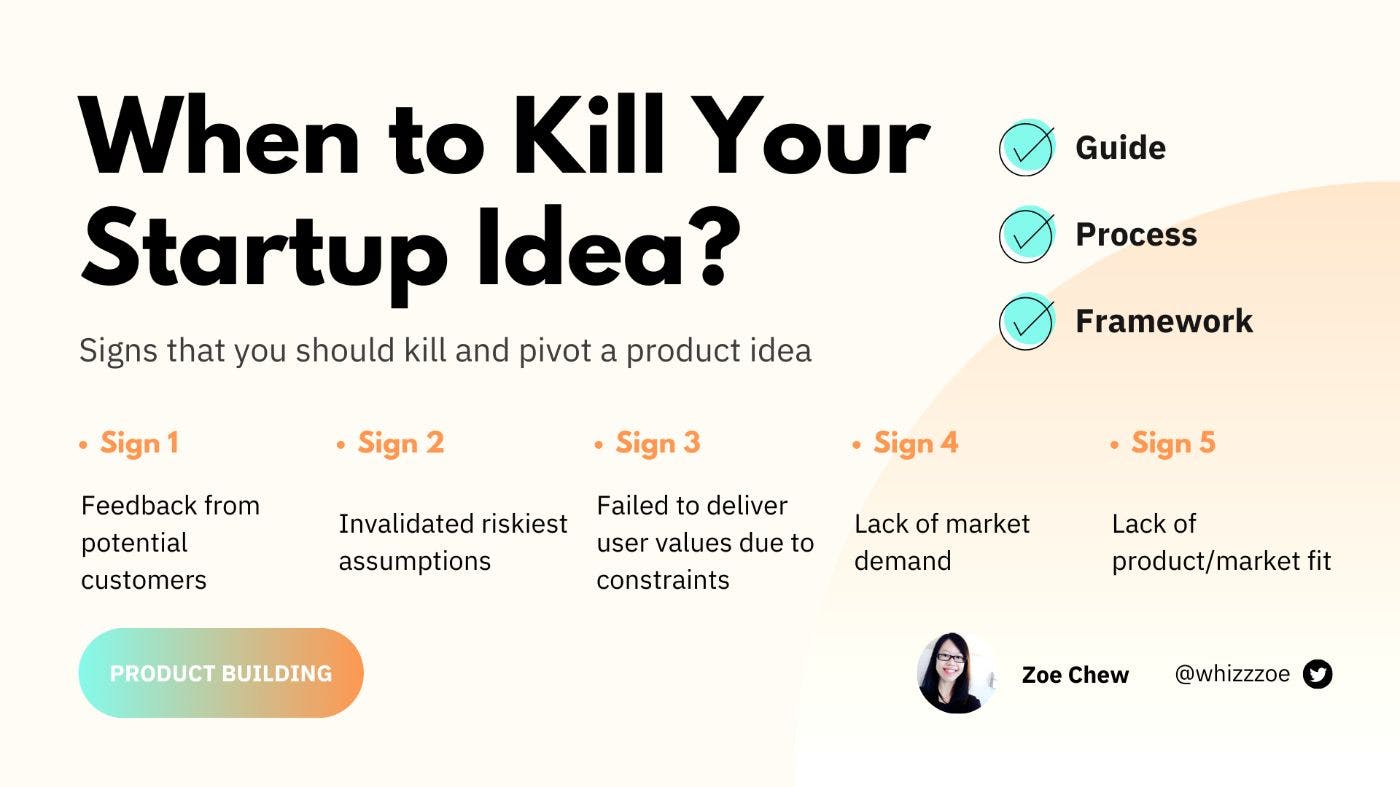As a product builder, I build things full-time, whether it’s a venture newsletter, micro-products or coaching founders to build tech products using my rapid MVP technique.
This post is one of my Multi-Part Product Guide series covering topics such as: Startup Framework, Idea Validation, Minimum Viable Products & No-Code MVP.
Many startups fail because they don't recognize the signs that their product isn't working and continue adding more features. You can avoid building something that no one wants if you recognize the warning signs early on. In this post, I'll explain how to tell if it's time to pivot or kill a product idea.
Factor 1: Invalidated Riskiest Assumptions
Jumping into building an MVP without assumption testing can lead to missing crucial signs. The riskiest assumptions are critical factors that can kill your startup, so they must be tested during the ideation and pre-product stages.
By conducting pre-product experiments, you can identify if customers care about the problem you're solving or if it's worth solving at all.
If experiments reveal that customers don't care about the problem you're solving, or the problem isn't worth solving—or the problem isn’t valid, it's time to kill the idea.
Example:
- 🤔 Problem assumption: There is a lack of variety in natural product options.
- 🙊 User feedback: Lack of affordable options is a bigger issue for customers than lack of variety.
- 🎯 What to do next: Focus on solving the bigger problem of affordability. If the assumption regarding affordability is validated, build upon this direction.
Factor 2: Can’t deliver great values to users
Differentiation becomes important in competitive markets such as farm produce, e-commerce, Fast Moving Consumer Goods and transportation services.
The higher the value of a product, the more likely it is that you will be able to differentiate, monetize and build a profitable business.
Customers will only pay for your solution if it provides values. Here are different ways to create values for your users:
- Functional value—How well a product solves a user's problem, i.e. by considering product features, benefits and performance.
- Monetary value—How this product can help people save money. For example, lowering cost and expenses, getting more quality for less money, and so on.
- Emotional value—How does this product make you feel after you use it?
- Social value—How does this product fulfil a person’s social status or influence within their social circle or community?
Example:
- 📲 Situation: You have free users for your no-code mobile app but struggle to monetize due to the need to expand the product features and create paid offerings.
- 😲 Why it won’t work: Expectations rise as software becomes more widely available. Customers will only pay more for a product if it provides better value in comparison to competitors’ solution.
- 🔥 What to do next: Consider seeking additional resources (technical, capital or expertise) to develop products that can deliver significant value to users. If your goal is to become a solo/lifestyle business, consider working on viable ideas that you can monetize while still providing great value to users.
Factor 3: Lack of product/market fit
When there is a lack of product-market fit, it is unlikely that the product will become sustainable in the long-term. This is because…
- There aren’t enough customers buying the product in the intended target market
- There aren’t enough customers raving about your product, thus increases the need for paid marketing and customer acquisition cost
- Insufficient channel/market fit—marketing channels are ineffective because the product does not resonate with the target market.
- There aren’t enough repeat customers due to a lack of satisfied customers, which leads to low sales and revenue.
Example:
- 🏀👟Situation: You have built an online marketplace for buying and selling used sneakers, with initial paid users in a small target market. However, you're struggling to expand to a larger market size.
- 🗺️ Why it won't work: The product is not performing well in other areas, regions or countries, limiting potential sales and revenue. Slow growth and low retention rates also indicate a lack of product-market fit.
- 📍 What to do next: Pivot the business to focus on a different product or market. For example, explore other categories of products with higher resale potential and target a broader audience to achieve greater revenue and growth potential.
🚀 Takeaway
- To pivot a product means changing its direction to better cater to the market's needs, while killing an idea means stopping its development and completely switching to a new idea.
- Listening to customer feedback, analyzing data and mastering market needs to shape the direction of your product.
- You’re not married to a product idea. In fact, great founders change their idea when needed without abandoning their vision. E.g. Slack was originally developed as a gaming platform that failed to take off.
- Rapid experimentation is key. Observe when certain product features don't resonate with the target customers, identify customer dissatisfaction, and recognize obstacles to gaining traction.
- Don’t shy away from building new products in competitive markets. Lyft and Uber competes for ride-sharing services but have differentiated themselves with various business moats.
Also published here.


